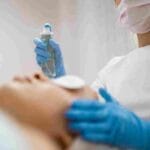
Skin Care Trends 2025: What’s Hot in Coral Gables
February 12, 2025
Best Chemical Peels for Acne Scars: Which One Works for You?
February 16, 2025Embarking on the journey of skin rejuvenation through a chemical peel is an exciting endeavour. This treatment can unveil a fresher, more radiant complexion by removing damaged outer layers of skin. However, achieving the best results hinges not only on the procedure itself but also on diligent aftercare.
In this comprehensive guide, we’ll explore essential chemical peel aftercare tips to ensure your skin heals properly and you enjoy optimal outcomes.
Key Takeaways
- Gentle Cleansing: Use cool water and mild, soap-free cleansers to wash your face, avoiding hot water and abrasive tools.
- Moisturization: Keep your skin hydrated with appropriate moisturizers to promote healing and comfort.
- Sun Protection: Apply a broad-spectrum sunscreen with at least SPF 30 to shield your sensitive skin from harmful UV rays.
- Avoid Picking: Resist the urge to peel or pick at flaking skin to prevent scarring and infection.
- Limit Exfoliation: Steer clear of additional exfoliating products until your skin has fully healed.
Overview
Proper aftercare following a chemical peel is crucial for achieving the desired skin rejuvenation results. This involves gentle cleansing, adequate moisturization, diligent sun protection, and patience to allow the skin to heal naturally. Avoiding certain activities and products can prevent complications and support the skin’s recovery process.
Gentle Cleansing
After a chemical peel, your skin becomes particularly sensitive, so following proper chemical peel aftercare tips is crucial. Cleanse your face with cool water and a mild, soap-free cleanser to avoid irritation. Refrain from using hot water, as it can further agitate the skin. Instead of abrasive tools like washcloths or sponges, gently cleanse your skin with your fingertips. This approach helps maintain the skin’s integrity and promotes healing, ensuring the best results from your chemical peel treatment.
Moisturization
Keeping your skin moisturized is vital during the healing process. Applying a suitable moisturizer helps alleviate dryness and supports the skin’s natural barrier. Opt for products free from harsh chemicals and irritants. Water-based moisturizers are often recommended due to their lightweight nature. Regular application will aid in reducing discomfort and facilitate recovery.
Sun Protection
Post-peel, your skin is more susceptible to sun damage. It’s imperative to apply a broad-spectrum sunscreen with at least SPF 30 daily. This practice protects your healing skin from harmful UV rays, which can cause complications and affect the results of the peel. Even on cloudy days or when indoors near windows, sunscreen application remains essential.
Avoid Picking and Peeling
As your skin heals, you may notice peeling or flaking. It’s crucial to resist the temptation to pick at or peel the skin. Interfering with the natural shedding process can lead to scarring, infection, or prolonged healing times. By following proper chemical peel aftercare tips, you can allow the skin to exfoliate naturally, ensuring the best possible outcome for smoother, healthier skin.
Limit Exfoliation
Given that a chemical peel already provides significant exfoliation, it’s advisable to avoid using additional exfoliating products until your skin has fully recovered. This includes scrubs, brushes, or exfoliating cleansers, which can cause further irritation or damage to the sensitive, healing skin. Patience is key; allow your skin the time it needs to heal before reintroducing such products.
Conclusion
Caring for your skin after a chemical peel is a pivotal step in achieving the desired rejuvenation results. By adhering to these aftercare tips, you can support your skin’s natural healing process and enjoy a revitalized, radiant complexion. Remember, patience and gentle care are your allies in this journey. If you have any concerns or questions during your recovery, don’t hesitate to reach out to your skincare professional for personalized advice.
At Pōk Aesthetic Bar, we understand the importance of professional care in achieving optimal skin health. Our team is dedicated to providing personalized guidance and treatments tailored to your unique needs. Visit us at 4649 Ponce de Leon Blvd, Suite 406, Coral Gables, FL 33146, or call us at (786) 578-5303 to schedule a consultation. Let us assist you in navigating your post-peel journey with expert advice and care.
FAQs
Q: How soon can I wear makeup after a chemical peel?
A: It’s generally recommended to wait at least 24 hours before applying makeup. However, depending on the depth of the peel and your skin’s response, your provider may advise a longer waiting period. Always follow the specific guidance provided by your skincare professional.
Q: When can I resume my regular skincare routine?
A: You should hold off on resuming your regular skincare regimen until your skin has fully healed. This includes avoiding products containing retinol, alpha hydroxy acids (AHAs), or beta hydroxy acids (BHAs), which can be too harsh during the recovery phase. Typically, a waiting period of about two weeks is recommended, but this can vary based on individual healing processes.
Q: Is it normal to experience redness after a chemical peel?
A: Yes, experiencing redness is a common side effect following a chemical peel. The intensity and duration of redness can vary depending on the depth of the peel. For superficial peels, redness usually subsides within a few days, while deeper peels may result in redness lasting several weeks.
Q: How long does it take for the skin to fully heal after a chemical peel?
A: Healing time depends on the type of peel received. Superficial peels may heal within 3-7 days, while medium-depth peels can take 7-14 days. Deeper peels might require several weeks to a few months for complete recovery. Always follow the specific instructions given by your skincare professional.
Q: Can I exercise after a chemical peel?
A: It’s best to avoid intense workouts for at least 48 hours post-peel. Sweating can irritate your skin, leading to excessive redness, itching, or even breakouts. Opt for light activities like walking if needed, but avoid saunas, steam rooms, and hot showers.
Q: Is it normal for my skin to feel tight after a chemical peel?
A: Yes, tightness is a common sensation following a peel. As the skin sheds and regenerates, it may feel dry, tight, and slightly rough. Keeping your skin hydrated with a gentle, non-irritating moisturizer will help alleviate discomfort.
Q: Can I use ice or cold compresses to soothe my skin?
A: Yes, you can apply a cool (not frozen) compress to ease discomfort or reduce redness. However, avoid placing ice directly on the skin, as extreme cold can further irritate or damage the sensitive areas.
Q: How do I sleep after a chemical peel?
A: Try to sleep on your back with your head slightly elevated to minimize friction and avoid direct contact between your face and your pillow. Using a clean, soft pillowcase will help prevent bacteria from irritating your healing skin.

